Professional and Corporate Studies: Project Sustainability Report
VerifiedAdded on 2023/05/29
|13
|3344
|379
Report
AI Summary
This report provides a detailed analysis of the sustainability factors associated with a major project: the development of a new business and financial district in the Royal Albert Dockland area of East London. The project, involving a £1.7 billion investment and spanning 4.7 million square feet, aims to create a new commercial hub with residential zones, office buildings, and infrastructure improvements. The report critically evaluates the project's social sustainability, including the benefits of new residential areas and improved quality of life, while also addressing potential disadvantages such as overpopulation. The economic sustainability section assesses the impact on commercial activity and employment, alongside potential risks like transport access issues and lack of investment. Finally, the report examines the environmental sustainability, highlighting the potential for ecosystem restructuring and reduced congestion in the main city, but also acknowledges the significant environmental drawbacks such as ecosystem destruction and increased pollution. The analysis covers the project's benefits, disadvantages, and overall sustainability considerations, drawing conclusions on its long-term viability and impact.
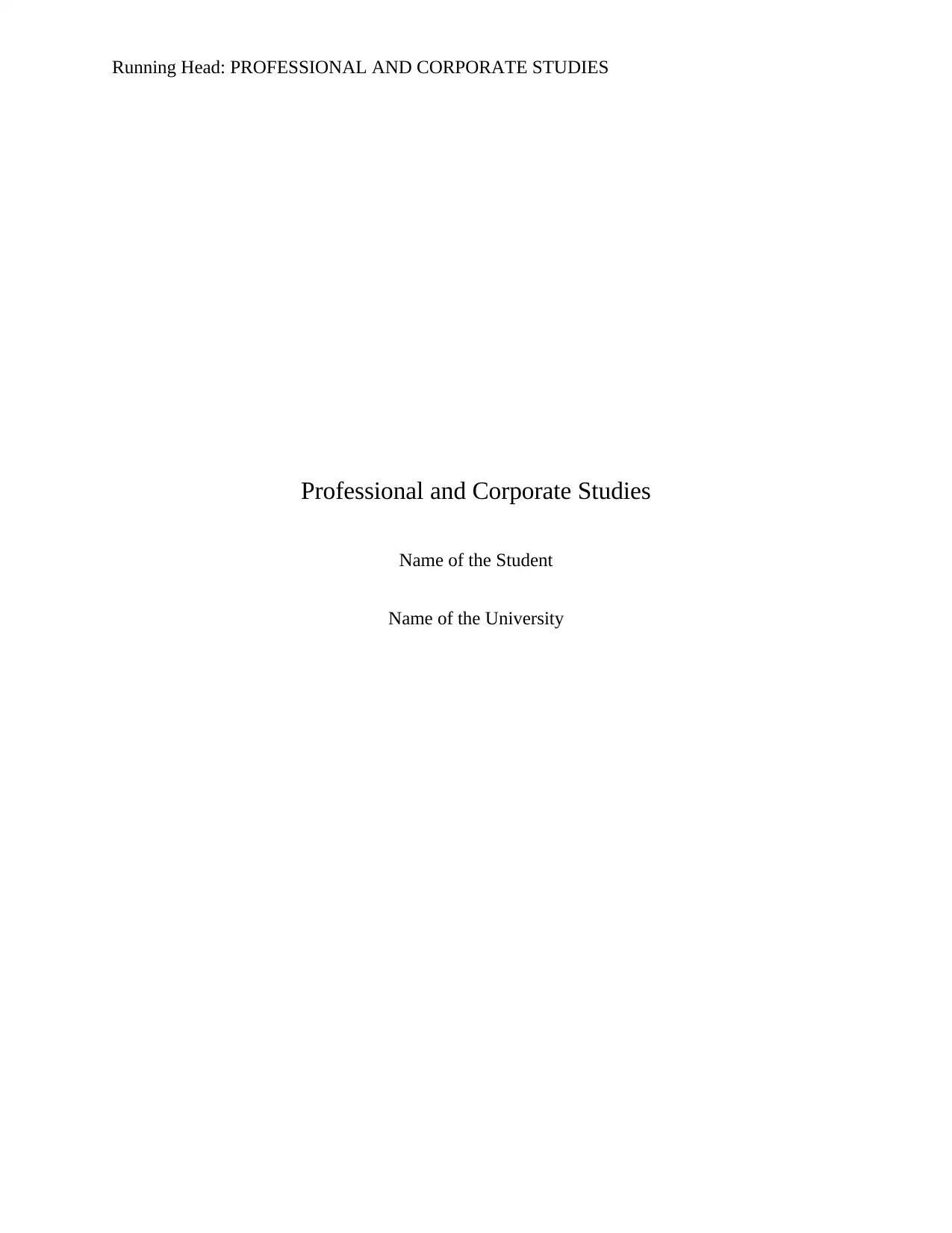
Running Head: PROFESSIONAL AND CORPORATE STUDIES
Professional and Corporate Studies
Name of the Student
Name of the University
Professional and Corporate Studies
Name of the Student
Name of the University
Paraphrase This Document
Need a fresh take? Get an instant paraphrase of this document with our AI Paraphraser
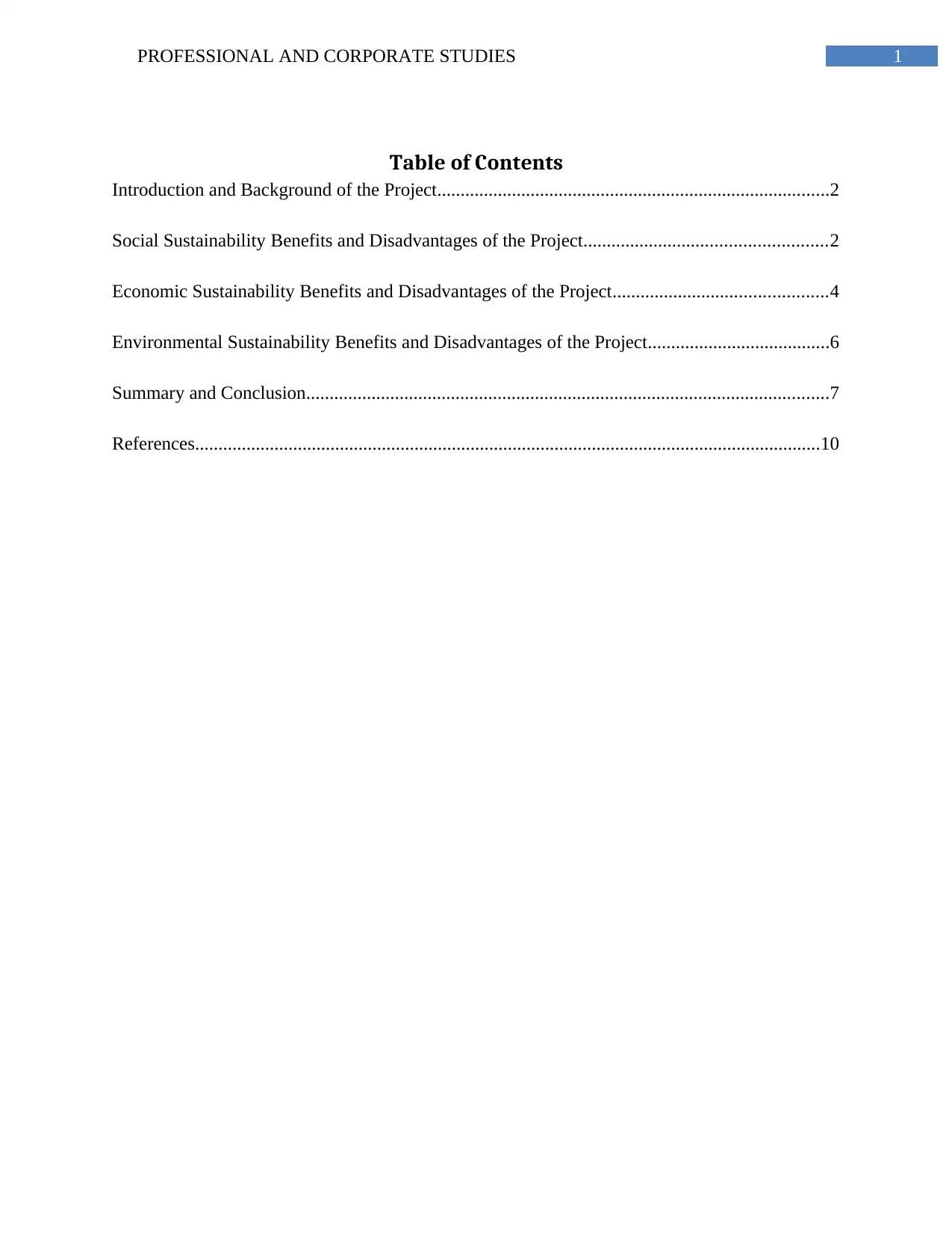
1PROFESSIONAL AND CORPORATE STUDIES
Table of Contents
Introduction and Background of the Project....................................................................................2
Social Sustainability Benefits and Disadvantages of the Project....................................................2
Economic Sustainability Benefits and Disadvantages of the Project..............................................4
Environmental Sustainability Benefits and Disadvantages of the Project.......................................6
Summary and Conclusion................................................................................................................7
References......................................................................................................................................10
Table of Contents
Introduction and Background of the Project....................................................................................2
Social Sustainability Benefits and Disadvantages of the Project....................................................2
Economic Sustainability Benefits and Disadvantages of the Project..............................................4
Environmental Sustainability Benefits and Disadvantages of the Project.......................................6
Summary and Conclusion................................................................................................................7
References......................................................................................................................................10
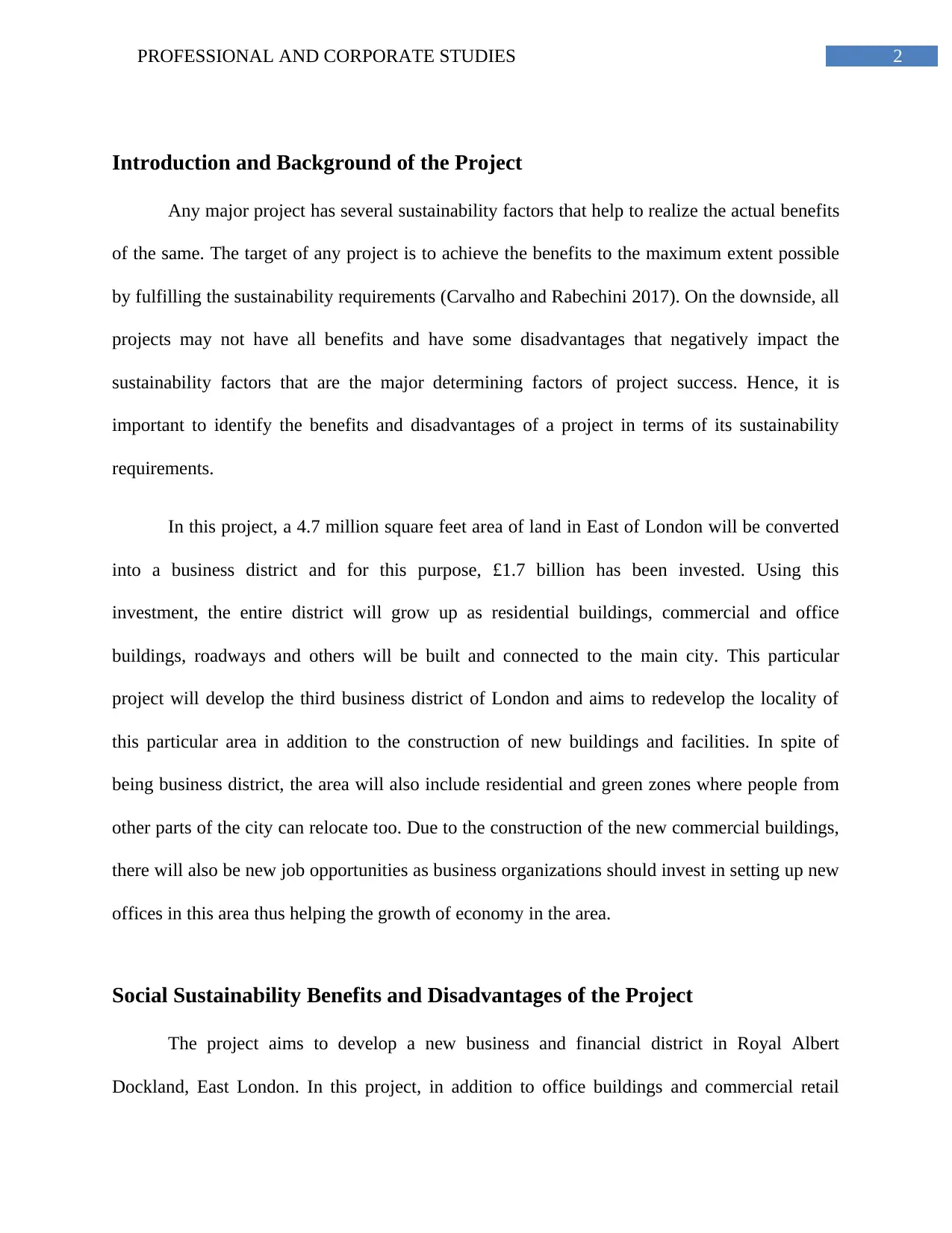
2PROFESSIONAL AND CORPORATE STUDIES
Introduction and Background of the Project
Any major project has several sustainability factors that help to realize the actual benefits
of the same. The target of any project is to achieve the benefits to the maximum extent possible
by fulfilling the sustainability requirements (Carvalho and Rabechini 2017). On the downside, all
projects may not have all benefits and have some disadvantages that negatively impact the
sustainability factors that are the major determining factors of project success. Hence, it is
important to identify the benefits and disadvantages of a project in terms of its sustainability
requirements.
In this project, a 4.7 million square feet area of land in East of London will be converted
into a business district and for this purpose, £1.7 billion has been invested. Using this
investment, the entire district will grow up as residential buildings, commercial and office
buildings, roadways and others will be built and connected to the main city. This particular
project will develop the third business district of London and aims to redevelop the locality of
this particular area in addition to the construction of new buildings and facilities. In spite of
being business district, the area will also include residential and green zones where people from
other parts of the city can relocate too. Due to the construction of the new commercial buildings,
there will also be new job opportunities as business organizations should invest in setting up new
offices in this area thus helping the growth of economy in the area.
Social Sustainability Benefits and Disadvantages of the Project
The project aims to develop a new business and financial district in Royal Albert
Dockland, East London. In this project, in addition to office buildings and commercial retail
Introduction and Background of the Project
Any major project has several sustainability factors that help to realize the actual benefits
of the same. The target of any project is to achieve the benefits to the maximum extent possible
by fulfilling the sustainability requirements (Carvalho and Rabechini 2017). On the downside, all
projects may not have all benefits and have some disadvantages that negatively impact the
sustainability factors that are the major determining factors of project success. Hence, it is
important to identify the benefits and disadvantages of a project in terms of its sustainability
requirements.
In this project, a 4.7 million square feet area of land in East of London will be converted
into a business district and for this purpose, £1.7 billion has been invested. Using this
investment, the entire district will grow up as residential buildings, commercial and office
buildings, roadways and others will be built and connected to the main city. This particular
project will develop the third business district of London and aims to redevelop the locality of
this particular area in addition to the construction of new buildings and facilities. In spite of
being business district, the area will also include residential and green zones where people from
other parts of the city can relocate too. Due to the construction of the new commercial buildings,
there will also be new job opportunities as business organizations should invest in setting up new
offices in this area thus helping the growth of economy in the area.
Social Sustainability Benefits and Disadvantages of the Project
The project aims to develop a new business and financial district in Royal Albert
Dockland, East London. In this project, in addition to office buildings and commercial retail
⊘ This is a preview!⊘
Do you want full access?
Subscribe today to unlock all pages.

Trusted by 1+ million students worldwide
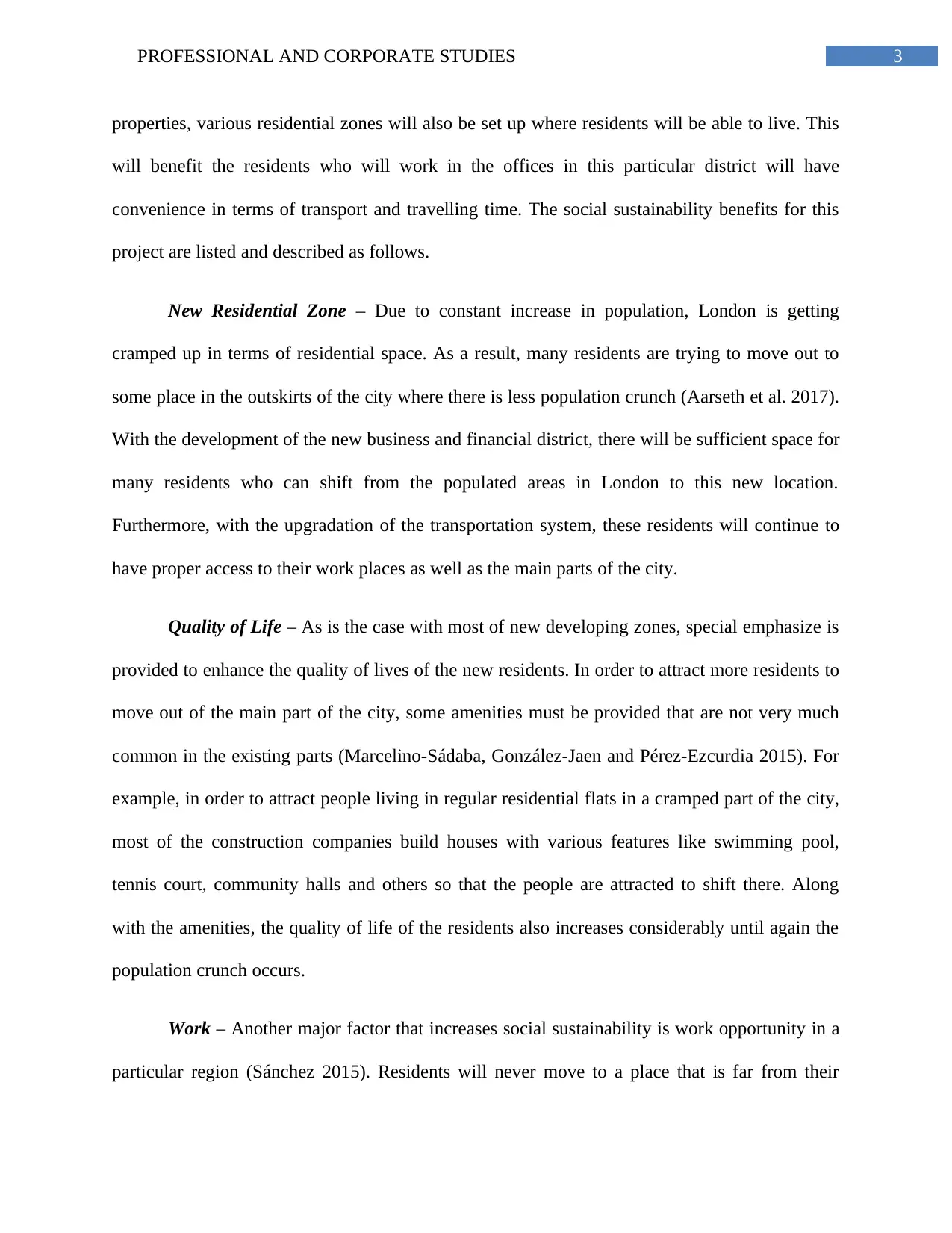
3PROFESSIONAL AND CORPORATE STUDIES
properties, various residential zones will also be set up where residents will be able to live. This
will benefit the residents who will work in the offices in this particular district will have
convenience in terms of transport and travelling time. The social sustainability benefits for this
project are listed and described as follows.
New Residential Zone – Due to constant increase in population, London is getting
cramped up in terms of residential space. As a result, many residents are trying to move out to
some place in the outskirts of the city where there is less population crunch (Aarseth et al. 2017).
With the development of the new business and financial district, there will be sufficient space for
many residents who can shift from the populated areas in London to this new location.
Furthermore, with the upgradation of the transportation system, these residents will continue to
have proper access to their work places as well as the main parts of the city.
Quality of Life – As is the case with most of new developing zones, special emphasize is
provided to enhance the quality of lives of the new residents. In order to attract more residents to
move out of the main part of the city, some amenities must be provided that are not very much
common in the existing parts (Marcelino-Sádaba, González-Jaen and Pérez-Ezcurdia 2015). For
example, in order to attract people living in regular residential flats in a cramped part of the city,
most of the construction companies build houses with various features like swimming pool,
tennis court, community halls and others so that the people are attracted to shift there. Along
with the amenities, the quality of life of the residents also increases considerably until again the
population crunch occurs.
Work – Another major factor that increases social sustainability is work opportunity in a
particular region (Sánchez 2015). Residents will never move to a place that is far from their
properties, various residential zones will also be set up where residents will be able to live. This
will benefit the residents who will work in the offices in this particular district will have
convenience in terms of transport and travelling time. The social sustainability benefits for this
project are listed and described as follows.
New Residential Zone – Due to constant increase in population, London is getting
cramped up in terms of residential space. As a result, many residents are trying to move out to
some place in the outskirts of the city where there is less population crunch (Aarseth et al. 2017).
With the development of the new business and financial district, there will be sufficient space for
many residents who can shift from the populated areas in London to this new location.
Furthermore, with the upgradation of the transportation system, these residents will continue to
have proper access to their work places as well as the main parts of the city.
Quality of Life – As is the case with most of new developing zones, special emphasize is
provided to enhance the quality of lives of the new residents. In order to attract more residents to
move out of the main part of the city, some amenities must be provided that are not very much
common in the existing parts (Marcelino-Sádaba, González-Jaen and Pérez-Ezcurdia 2015). For
example, in order to attract people living in regular residential flats in a cramped part of the city,
most of the construction companies build houses with various features like swimming pool,
tennis court, community halls and others so that the people are attracted to shift there. Along
with the amenities, the quality of life of the residents also increases considerably until again the
population crunch occurs.
Work – Another major factor that increases social sustainability is work opportunity in a
particular region (Sánchez 2015). Residents will never move to a place that is far from their
Paraphrase This Document
Need a fresh take? Get an instant paraphrase of this document with our AI Paraphraser
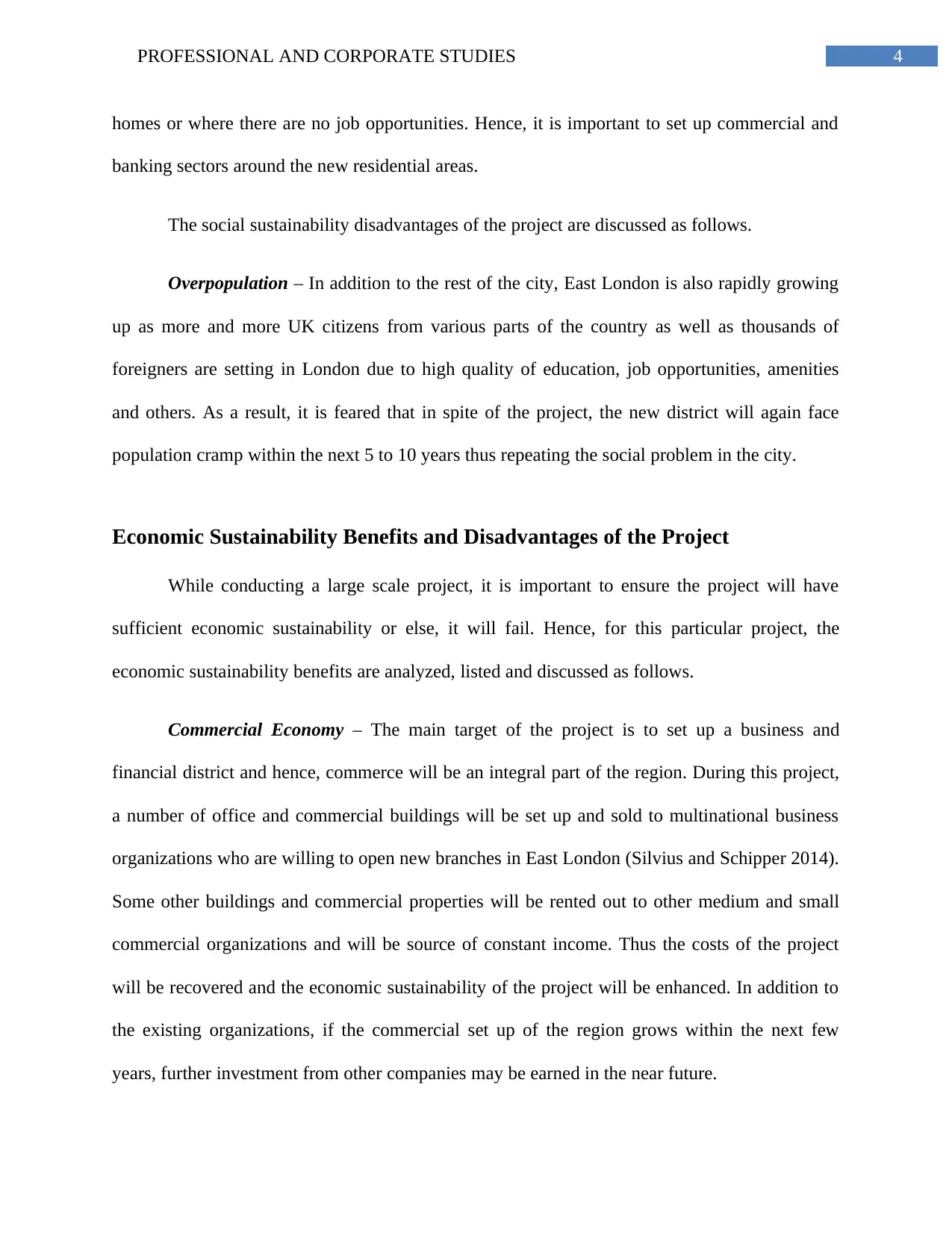
4PROFESSIONAL AND CORPORATE STUDIES
homes or where there are no job opportunities. Hence, it is important to set up commercial and
banking sectors around the new residential areas.
The social sustainability disadvantages of the project are discussed as follows.
Overpopulation – In addition to the rest of the city, East London is also rapidly growing
up as more and more UK citizens from various parts of the country as well as thousands of
foreigners are setting in London due to high quality of education, job opportunities, amenities
and others. As a result, it is feared that in spite of the project, the new district will again face
population cramp within the next 5 to 10 years thus repeating the social problem in the city.
Economic Sustainability Benefits and Disadvantages of the Project
While conducting a large scale project, it is important to ensure the project will have
sufficient economic sustainability or else, it will fail. Hence, for this particular project, the
economic sustainability benefits are analyzed, listed and discussed as follows.
Commercial Economy – The main target of the project is to set up a business and
financial district and hence, commerce will be an integral part of the region. During this project,
a number of office and commercial buildings will be set up and sold to multinational business
organizations who are willing to open new branches in East London (Silvius and Schipper 2014).
Some other buildings and commercial properties will be rented out to other medium and small
commercial organizations and will be source of constant income. Thus the costs of the project
will be recovered and the economic sustainability of the project will be enhanced. In addition to
the existing organizations, if the commercial set up of the region grows within the next few
years, further investment from other companies may be earned in the near future.
homes or where there are no job opportunities. Hence, it is important to set up commercial and
banking sectors around the new residential areas.
The social sustainability disadvantages of the project are discussed as follows.
Overpopulation – In addition to the rest of the city, East London is also rapidly growing
up as more and more UK citizens from various parts of the country as well as thousands of
foreigners are setting in London due to high quality of education, job opportunities, amenities
and others. As a result, it is feared that in spite of the project, the new district will again face
population cramp within the next 5 to 10 years thus repeating the social problem in the city.
Economic Sustainability Benefits and Disadvantages of the Project
While conducting a large scale project, it is important to ensure the project will have
sufficient economic sustainability or else, it will fail. Hence, for this particular project, the
economic sustainability benefits are analyzed, listed and discussed as follows.
Commercial Economy – The main target of the project is to set up a business and
financial district and hence, commerce will be an integral part of the region. During this project,
a number of office and commercial buildings will be set up and sold to multinational business
organizations who are willing to open new branches in East London (Silvius and Schipper 2014).
Some other buildings and commercial properties will be rented out to other medium and small
commercial organizations and will be source of constant income. Thus the costs of the project
will be recovered and the economic sustainability of the project will be enhanced. In addition to
the existing organizations, if the commercial set up of the region grows within the next few
years, further investment from other companies may be earned in the near future.
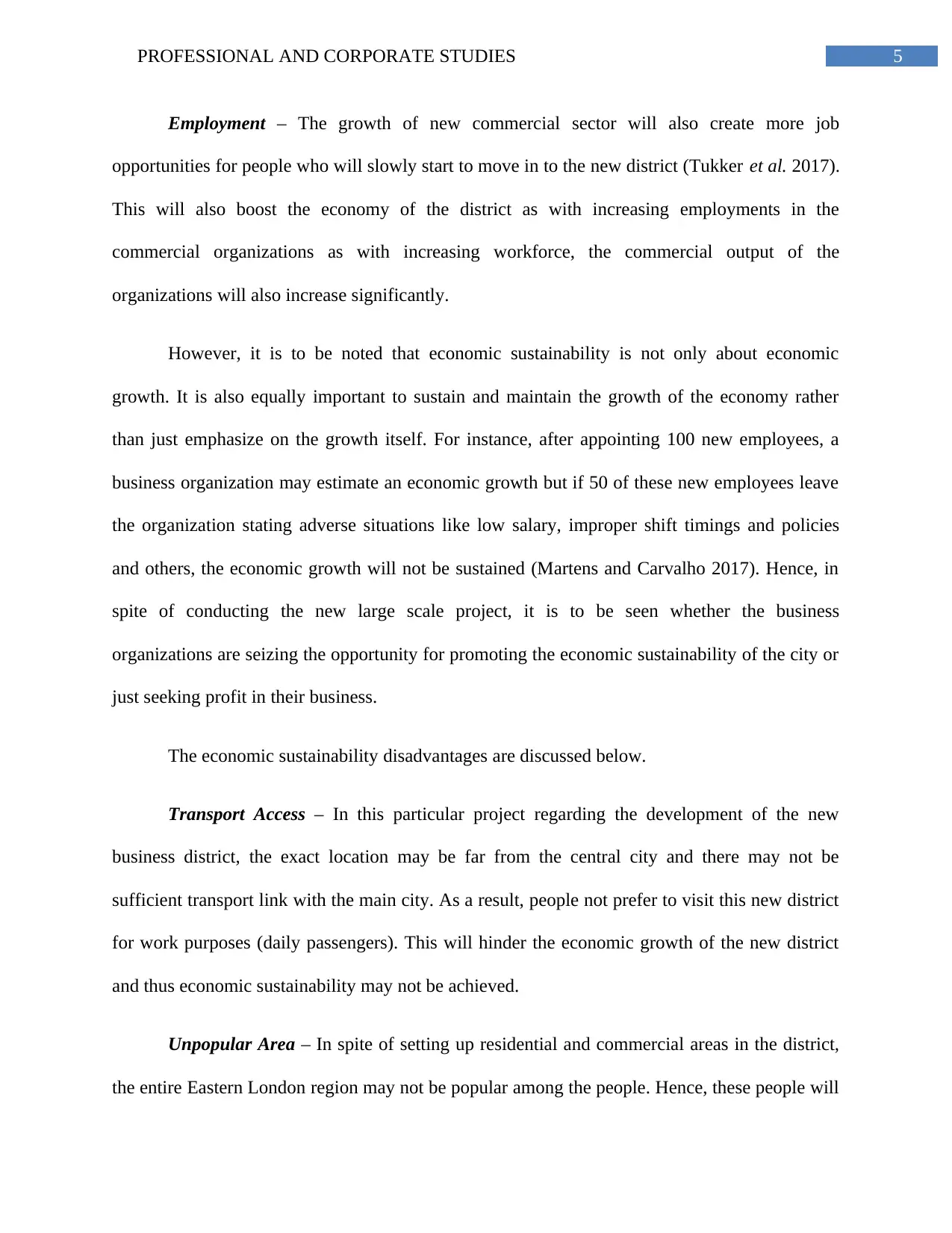
5PROFESSIONAL AND CORPORATE STUDIES
Employment – The growth of new commercial sector will also create more job
opportunities for people who will slowly start to move in to the new district (Tukker et al. 2017).
This will also boost the economy of the district as with increasing employments in the
commercial organizations as with increasing workforce, the commercial output of the
organizations will also increase significantly.
However, it is to be noted that economic sustainability is not only about economic
growth. It is also equally important to sustain and maintain the growth of the economy rather
than just emphasize on the growth itself. For instance, after appointing 100 new employees, a
business organization may estimate an economic growth but if 50 of these new employees leave
the organization stating adverse situations like low salary, improper shift timings and policies
and others, the economic growth will not be sustained (Martens and Carvalho 2017). Hence, in
spite of conducting the new large scale project, it is to be seen whether the business
organizations are seizing the opportunity for promoting the economic sustainability of the city or
just seeking profit in their business.
The economic sustainability disadvantages are discussed below.
Transport Access – In this particular project regarding the development of the new
business district, the exact location may be far from the central city and there may not be
sufficient transport link with the main city. As a result, people not prefer to visit this new district
for work purposes (daily passengers). This will hinder the economic growth of the new district
and thus economic sustainability may not be achieved.
Unpopular Area – In spite of setting up residential and commercial areas in the district,
the entire Eastern London region may not be popular among the people. Hence, these people will
Employment – The growth of new commercial sector will also create more job
opportunities for people who will slowly start to move in to the new district (Tukker et al. 2017).
This will also boost the economy of the district as with increasing employments in the
commercial organizations as with increasing workforce, the commercial output of the
organizations will also increase significantly.
However, it is to be noted that economic sustainability is not only about economic
growth. It is also equally important to sustain and maintain the growth of the economy rather
than just emphasize on the growth itself. For instance, after appointing 100 new employees, a
business organization may estimate an economic growth but if 50 of these new employees leave
the organization stating adverse situations like low salary, improper shift timings and policies
and others, the economic growth will not be sustained (Martens and Carvalho 2017). Hence, in
spite of conducting the new large scale project, it is to be seen whether the business
organizations are seizing the opportunity for promoting the economic sustainability of the city or
just seeking profit in their business.
The economic sustainability disadvantages are discussed below.
Transport Access – In this particular project regarding the development of the new
business district, the exact location may be far from the central city and there may not be
sufficient transport link with the main city. As a result, people not prefer to visit this new district
for work purposes (daily passengers). This will hinder the economic growth of the new district
and thus economic sustainability may not be achieved.
Unpopular Area – In spite of setting up residential and commercial areas in the district,
the entire Eastern London region may not be popular among the people. Hence, these people will
⊘ This is a preview!⊘
Do you want full access?
Subscribe today to unlock all pages.

Trusted by 1+ million students worldwide
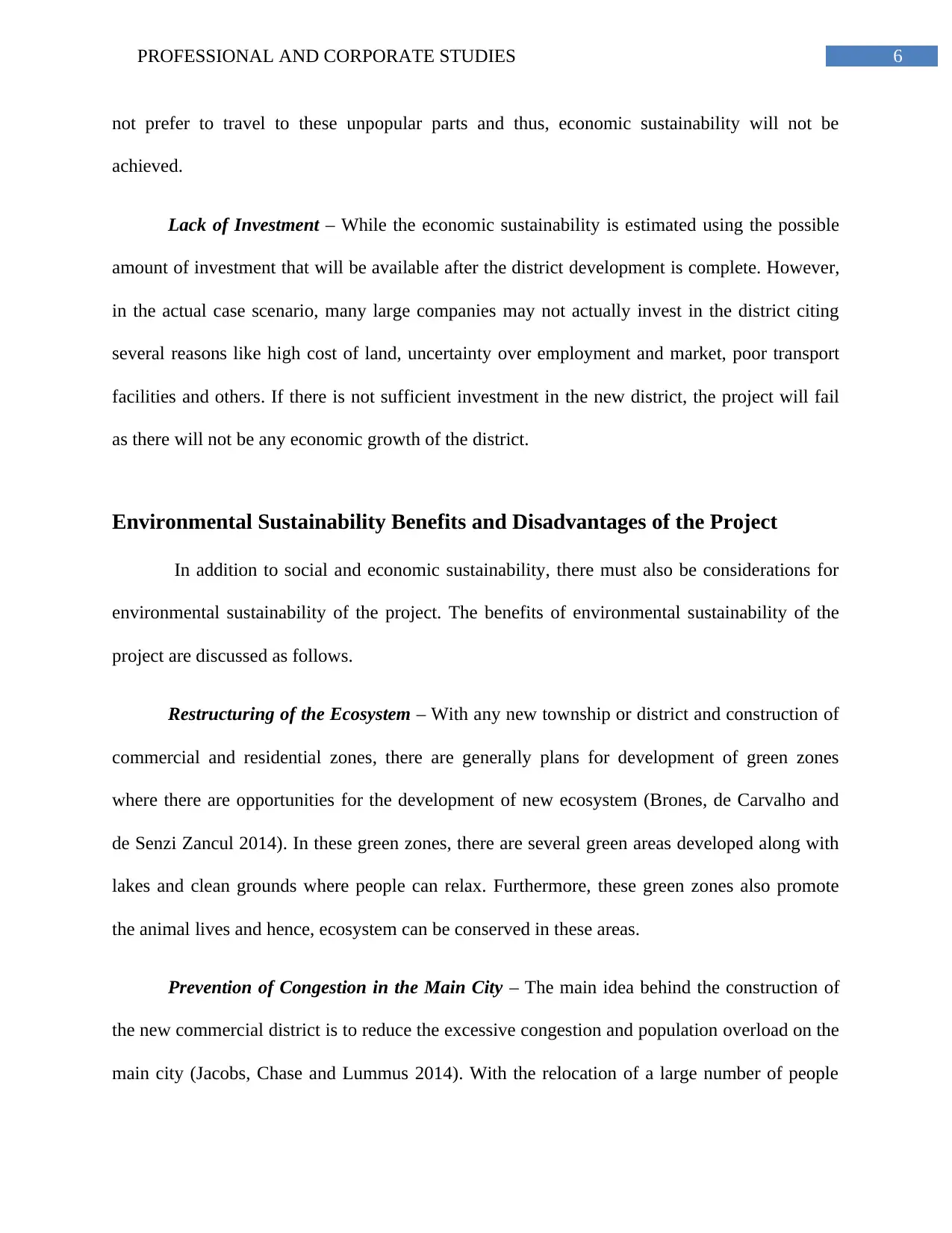
6PROFESSIONAL AND CORPORATE STUDIES
not prefer to travel to these unpopular parts and thus, economic sustainability will not be
achieved.
Lack of Investment – While the economic sustainability is estimated using the possible
amount of investment that will be available after the district development is complete. However,
in the actual case scenario, many large companies may not actually invest in the district citing
several reasons like high cost of land, uncertainty over employment and market, poor transport
facilities and others. If there is not sufficient investment in the new district, the project will fail
as there will not be any economic growth of the district.
Environmental Sustainability Benefits and Disadvantages of the Project
In addition to social and economic sustainability, there must also be considerations for
environmental sustainability of the project. The benefits of environmental sustainability of the
project are discussed as follows.
Restructuring of the Ecosystem – With any new township or district and construction of
commercial and residential zones, there are generally plans for development of green zones
where there are opportunities for the development of new ecosystem (Brones, de Carvalho and
de Senzi Zancul 2014). In these green zones, there are several green areas developed along with
lakes and clean grounds where people can relax. Furthermore, these green zones also promote
the animal lives and hence, ecosystem can be conserved in these areas.
Prevention of Congestion in the Main City – The main idea behind the construction of
the new commercial district is to reduce the excessive congestion and population overload on the
main city (Jacobs, Chase and Lummus 2014). With the relocation of a large number of people
not prefer to travel to these unpopular parts and thus, economic sustainability will not be
achieved.
Lack of Investment – While the economic sustainability is estimated using the possible
amount of investment that will be available after the district development is complete. However,
in the actual case scenario, many large companies may not actually invest in the district citing
several reasons like high cost of land, uncertainty over employment and market, poor transport
facilities and others. If there is not sufficient investment in the new district, the project will fail
as there will not be any economic growth of the district.
Environmental Sustainability Benefits and Disadvantages of the Project
In addition to social and economic sustainability, there must also be considerations for
environmental sustainability of the project. The benefits of environmental sustainability of the
project are discussed as follows.
Restructuring of the Ecosystem – With any new township or district and construction of
commercial and residential zones, there are generally plans for development of green zones
where there are opportunities for the development of new ecosystem (Brones, de Carvalho and
de Senzi Zancul 2014). In these green zones, there are several green areas developed along with
lakes and clean grounds where people can relax. Furthermore, these green zones also promote
the animal lives and hence, ecosystem can be conserved in these areas.
Prevention of Congestion in the Main City – The main idea behind the construction of
the new commercial district is to reduce the excessive congestion and population overload on the
main city (Jacobs, Chase and Lummus 2014). With the relocation of a large number of people
Paraphrase This Document
Need a fresh take? Get an instant paraphrase of this document with our AI Paraphraser
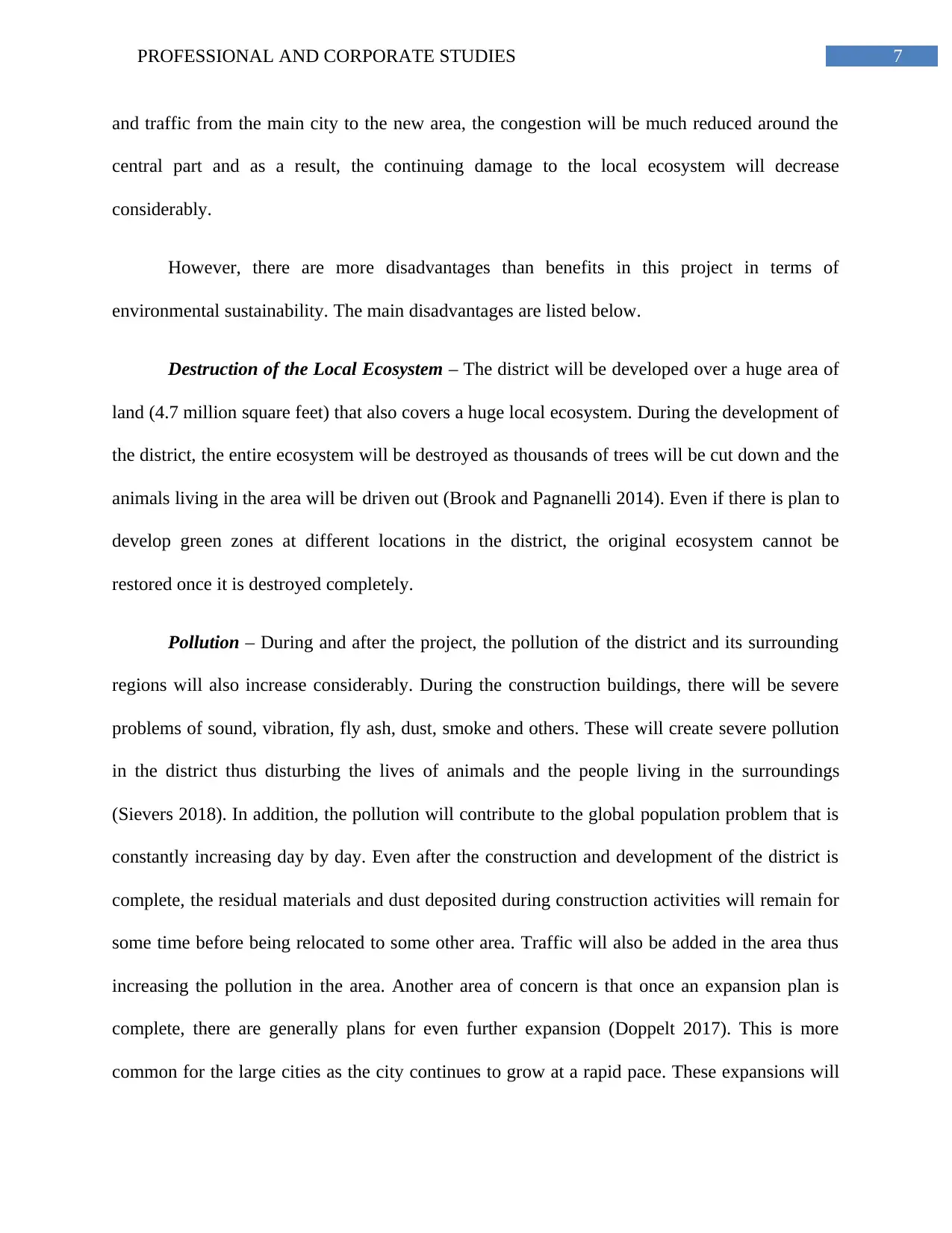
7PROFESSIONAL AND CORPORATE STUDIES
and traffic from the main city to the new area, the congestion will be much reduced around the
central part and as a result, the continuing damage to the local ecosystem will decrease
considerably.
However, there are more disadvantages than benefits in this project in terms of
environmental sustainability. The main disadvantages are listed below.
Destruction of the Local Ecosystem – The district will be developed over a huge area of
land (4.7 million square feet) that also covers a huge local ecosystem. During the development of
the district, the entire ecosystem will be destroyed as thousands of trees will be cut down and the
animals living in the area will be driven out (Brook and Pagnanelli 2014). Even if there is plan to
develop green zones at different locations in the district, the original ecosystem cannot be
restored once it is destroyed completely.
Pollution – During and after the project, the pollution of the district and its surrounding
regions will also increase considerably. During the construction buildings, there will be severe
problems of sound, vibration, fly ash, dust, smoke and others. These will create severe pollution
in the district thus disturbing the lives of animals and the people living in the surroundings
(Sievers 2018). In addition, the pollution will contribute to the global population problem that is
constantly increasing day by day. Even after the construction and development of the district is
complete, the residual materials and dust deposited during construction activities will remain for
some time before being relocated to some other area. Traffic will also be added in the area thus
increasing the pollution in the area. Another area of concern is that once an expansion plan is
complete, there are generally plans for even further expansion (Doppelt 2017). This is more
common for the large cities as the city continues to grow at a rapid pace. These expansions will
and traffic from the main city to the new area, the congestion will be much reduced around the
central part and as a result, the continuing damage to the local ecosystem will decrease
considerably.
However, there are more disadvantages than benefits in this project in terms of
environmental sustainability. The main disadvantages are listed below.
Destruction of the Local Ecosystem – The district will be developed over a huge area of
land (4.7 million square feet) that also covers a huge local ecosystem. During the development of
the district, the entire ecosystem will be destroyed as thousands of trees will be cut down and the
animals living in the area will be driven out (Brook and Pagnanelli 2014). Even if there is plan to
develop green zones at different locations in the district, the original ecosystem cannot be
restored once it is destroyed completely.
Pollution – During and after the project, the pollution of the district and its surrounding
regions will also increase considerably. During the construction buildings, there will be severe
problems of sound, vibration, fly ash, dust, smoke and others. These will create severe pollution
in the district thus disturbing the lives of animals and the people living in the surroundings
(Sievers 2018). In addition, the pollution will contribute to the global population problem that is
constantly increasing day by day. Even after the construction and development of the district is
complete, the residual materials and dust deposited during construction activities will remain for
some time before being relocated to some other area. Traffic will also be added in the area thus
increasing the pollution in the area. Another area of concern is that once an expansion plan is
complete, there are generally plans for even further expansion (Doppelt 2017). This is more
common for the large cities as the city continues to grow at a rapid pace. These expansions will
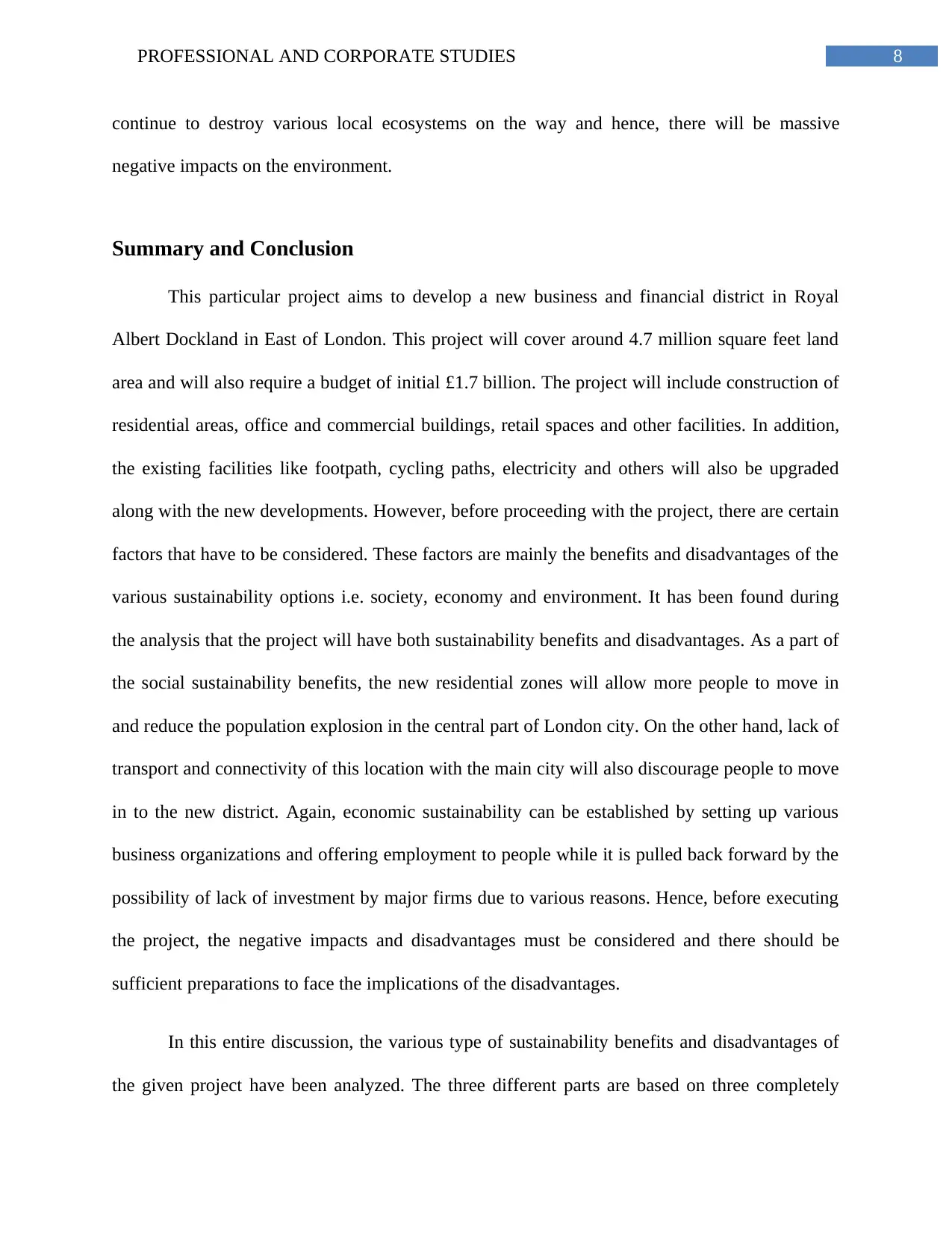
8PROFESSIONAL AND CORPORATE STUDIES
continue to destroy various local ecosystems on the way and hence, there will be massive
negative impacts on the environment.
Summary and Conclusion
This particular project aims to develop a new business and financial district in Royal
Albert Dockland in East of London. This project will cover around 4.7 million square feet land
area and will also require a budget of initial £1.7 billion. The project will include construction of
residential areas, office and commercial buildings, retail spaces and other facilities. In addition,
the existing facilities like footpath, cycling paths, electricity and others will also be upgraded
along with the new developments. However, before proceeding with the project, there are certain
factors that have to be considered. These factors are mainly the benefits and disadvantages of the
various sustainability options i.e. society, economy and environment. It has been found during
the analysis that the project will have both sustainability benefits and disadvantages. As a part of
the social sustainability benefits, the new residential zones will allow more people to move in
and reduce the population explosion in the central part of London city. On the other hand, lack of
transport and connectivity of this location with the main city will also discourage people to move
in to the new district. Again, economic sustainability can be established by setting up various
business organizations and offering employment to people while it is pulled back forward by the
possibility of lack of investment by major firms due to various reasons. Hence, before executing
the project, the negative impacts and disadvantages must be considered and there should be
sufficient preparations to face the implications of the disadvantages.
In this entire discussion, the various type of sustainability benefits and disadvantages of
the given project have been analyzed. The three different parts are based on three completely
continue to destroy various local ecosystems on the way and hence, there will be massive
negative impacts on the environment.
Summary and Conclusion
This particular project aims to develop a new business and financial district in Royal
Albert Dockland in East of London. This project will cover around 4.7 million square feet land
area and will also require a budget of initial £1.7 billion. The project will include construction of
residential areas, office and commercial buildings, retail spaces and other facilities. In addition,
the existing facilities like footpath, cycling paths, electricity and others will also be upgraded
along with the new developments. However, before proceeding with the project, there are certain
factors that have to be considered. These factors are mainly the benefits and disadvantages of the
various sustainability options i.e. society, economy and environment. It has been found during
the analysis that the project will have both sustainability benefits and disadvantages. As a part of
the social sustainability benefits, the new residential zones will allow more people to move in
and reduce the population explosion in the central part of London city. On the other hand, lack of
transport and connectivity of this location with the main city will also discourage people to move
in to the new district. Again, economic sustainability can be established by setting up various
business organizations and offering employment to people while it is pulled back forward by the
possibility of lack of investment by major firms due to various reasons. Hence, before executing
the project, the negative impacts and disadvantages must be considered and there should be
sufficient preparations to face the implications of the disadvantages.
In this entire discussion, the various type of sustainability benefits and disadvantages of
the given project have been analyzed. The three different parts are based on three completely
⊘ This is a preview!⊘
Do you want full access?
Subscribe today to unlock all pages.

Trusted by 1+ million students worldwide
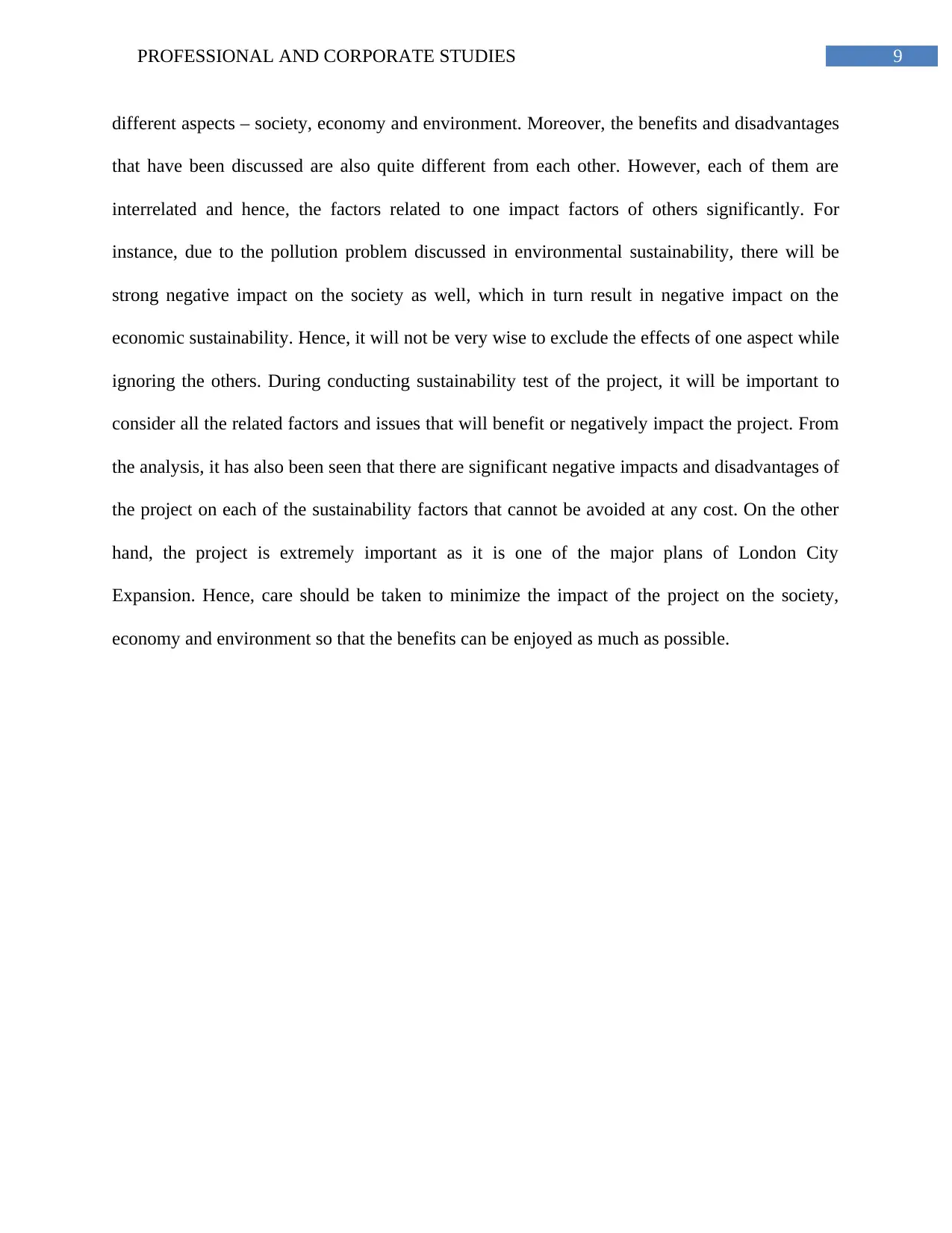
9PROFESSIONAL AND CORPORATE STUDIES
different aspects – society, economy and environment. Moreover, the benefits and disadvantages
that have been discussed are also quite different from each other. However, each of them are
interrelated and hence, the factors related to one impact factors of others significantly. For
instance, due to the pollution problem discussed in environmental sustainability, there will be
strong negative impact on the society as well, which in turn result in negative impact on the
economic sustainability. Hence, it will not be very wise to exclude the effects of one aspect while
ignoring the others. During conducting sustainability test of the project, it will be important to
consider all the related factors and issues that will benefit or negatively impact the project. From
the analysis, it has also been seen that there are significant negative impacts and disadvantages of
the project on each of the sustainability factors that cannot be avoided at any cost. On the other
hand, the project is extremely important as it is one of the major plans of London City
Expansion. Hence, care should be taken to minimize the impact of the project on the society,
economy and environment so that the benefits can be enjoyed as much as possible.
different aspects – society, economy and environment. Moreover, the benefits and disadvantages
that have been discussed are also quite different from each other. However, each of them are
interrelated and hence, the factors related to one impact factors of others significantly. For
instance, due to the pollution problem discussed in environmental sustainability, there will be
strong negative impact on the society as well, which in turn result in negative impact on the
economic sustainability. Hence, it will not be very wise to exclude the effects of one aspect while
ignoring the others. During conducting sustainability test of the project, it will be important to
consider all the related factors and issues that will benefit or negatively impact the project. From
the analysis, it has also been seen that there are significant negative impacts and disadvantages of
the project on each of the sustainability factors that cannot be avoided at any cost. On the other
hand, the project is extremely important as it is one of the major plans of London City
Expansion. Hence, care should be taken to minimize the impact of the project on the society,
economy and environment so that the benefits can be enjoyed as much as possible.
Paraphrase This Document
Need a fresh take? Get an instant paraphrase of this document with our AI Paraphraser
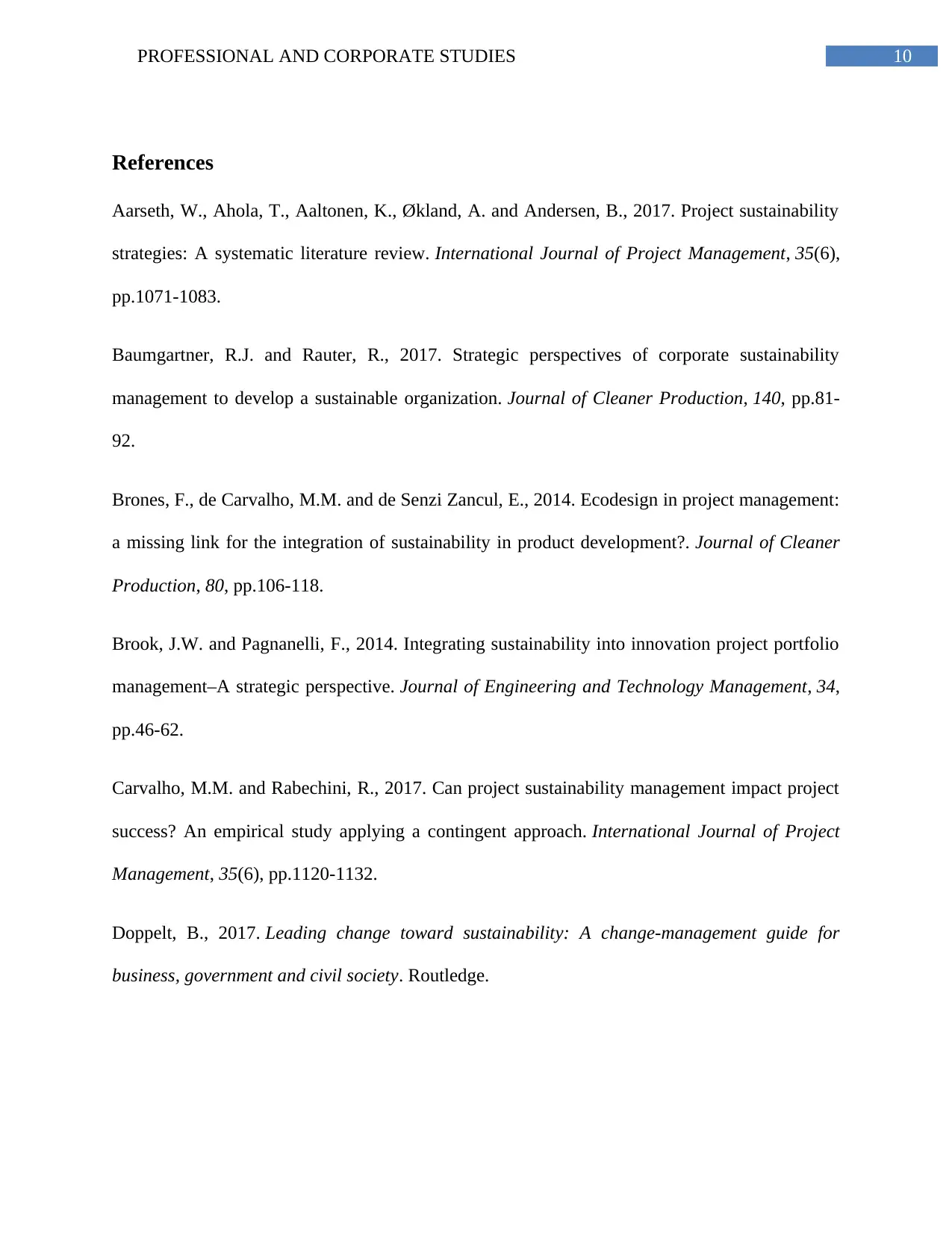
10PROFESSIONAL AND CORPORATE STUDIES
References
Aarseth, W., Ahola, T., Aaltonen, K., Økland, A. and Andersen, B., 2017. Project sustainability
strategies: A systematic literature review. International Journal of Project Management, 35(6),
pp.1071-1083.
Baumgartner, R.J. and Rauter, R., 2017. Strategic perspectives of corporate sustainability
management to develop a sustainable organization. Journal of Cleaner Production, 140, pp.81-
92.
Brones, F., de Carvalho, M.M. and de Senzi Zancul, E., 2014. Ecodesign in project management:
a missing link for the integration of sustainability in product development?. Journal of Cleaner
Production, 80, pp.106-118.
Brook, J.W. and Pagnanelli, F., 2014. Integrating sustainability into innovation project portfolio
management–A strategic perspective. Journal of Engineering and Technology Management, 34,
pp.46-62.
Carvalho, M.M. and Rabechini, R., 2017. Can project sustainability management impact project
success? An empirical study applying a contingent approach. International Journal of Project
Management, 35(6), pp.1120-1132.
Doppelt, B., 2017. Leading change toward sustainability: A change-management guide for
business, government and civil society. Routledge.
References
Aarseth, W., Ahola, T., Aaltonen, K., Økland, A. and Andersen, B., 2017. Project sustainability
strategies: A systematic literature review. International Journal of Project Management, 35(6),
pp.1071-1083.
Baumgartner, R.J. and Rauter, R., 2017. Strategic perspectives of corporate sustainability
management to develop a sustainable organization. Journal of Cleaner Production, 140, pp.81-
92.
Brones, F., de Carvalho, M.M. and de Senzi Zancul, E., 2014. Ecodesign in project management:
a missing link for the integration of sustainability in product development?. Journal of Cleaner
Production, 80, pp.106-118.
Brook, J.W. and Pagnanelli, F., 2014. Integrating sustainability into innovation project portfolio
management–A strategic perspective. Journal of Engineering and Technology Management, 34,
pp.46-62.
Carvalho, M.M. and Rabechini, R., 2017. Can project sustainability management impact project
success? An empirical study applying a contingent approach. International Journal of Project
Management, 35(6), pp.1120-1132.
Doppelt, B., 2017. Leading change toward sustainability: A change-management guide for
business, government and civil society. Routledge.
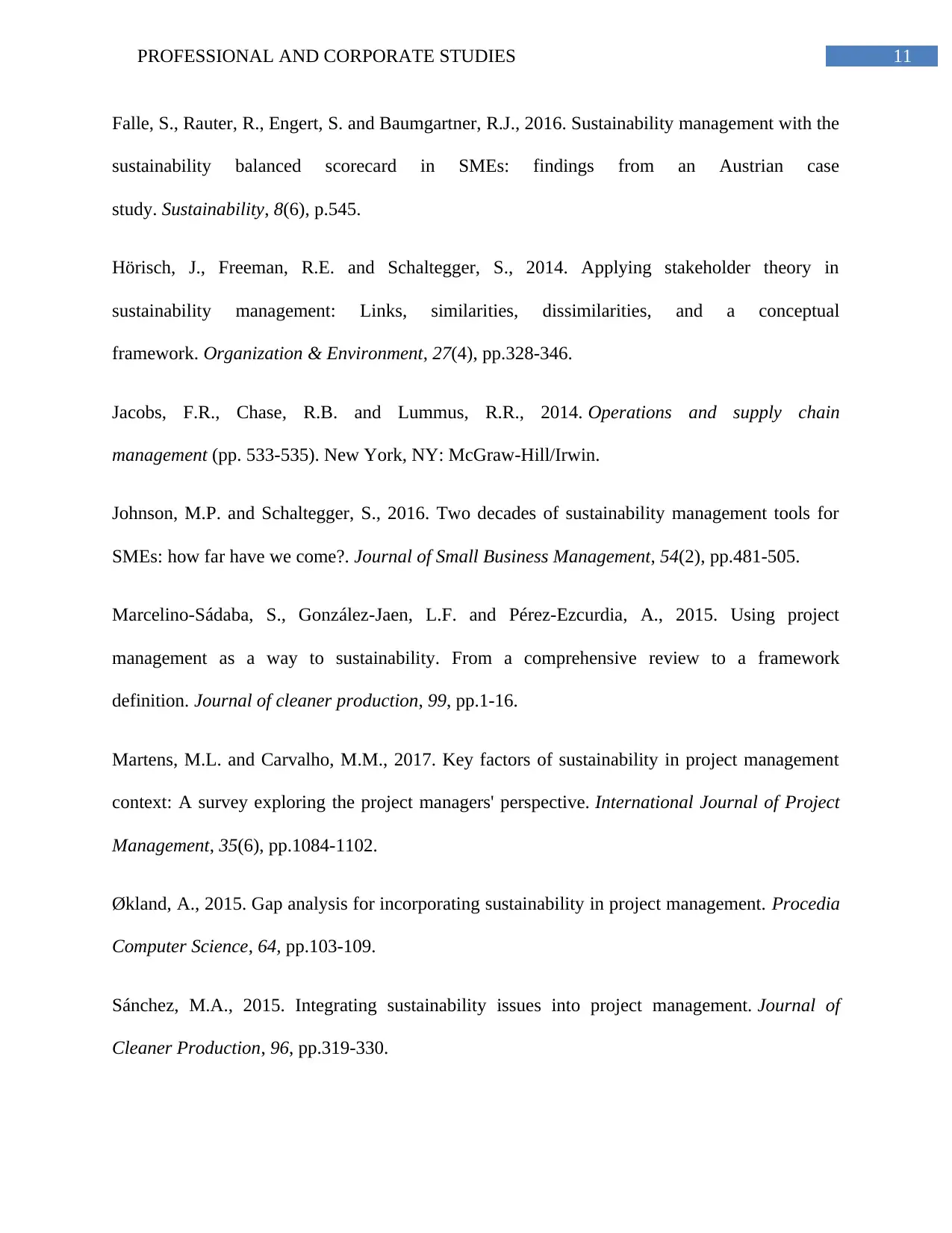
11PROFESSIONAL AND CORPORATE STUDIES
Falle, S., Rauter, R., Engert, S. and Baumgartner, R.J., 2016. Sustainability management with the
sustainability balanced scorecard in SMEs: findings from an Austrian case
study. Sustainability, 8(6), p.545.
Hörisch, J., Freeman, R.E. and Schaltegger, S., 2014. Applying stakeholder theory in
sustainability management: Links, similarities, dissimilarities, and a conceptual
framework. Organization & Environment, 27(4), pp.328-346.
Jacobs, F.R., Chase, R.B. and Lummus, R.R., 2014. Operations and supply chain
management (pp. 533-535). New York, NY: McGraw-Hill/Irwin.
Johnson, M.P. and Schaltegger, S., 2016. Two decades of sustainability management tools for
SMEs: how far have we come?. Journal of Small Business Management, 54(2), pp.481-505.
Marcelino-Sádaba, S., González-Jaen, L.F. and Pérez-Ezcurdia, A., 2015. Using project
management as a way to sustainability. From a comprehensive review to a framework
definition. Journal of cleaner production, 99, pp.1-16.
Martens, M.L. and Carvalho, M.M., 2017. Key factors of sustainability in project management
context: A survey exploring the project managers' perspective. International Journal of Project
Management, 35(6), pp.1084-1102.
Økland, A., 2015. Gap analysis for incorporating sustainability in project management. Procedia
Computer Science, 64, pp.103-109.
Sánchez, M.A., 2015. Integrating sustainability issues into project management. Journal of
Cleaner Production, 96, pp.319-330.
Falle, S., Rauter, R., Engert, S. and Baumgartner, R.J., 2016. Sustainability management with the
sustainability balanced scorecard in SMEs: findings from an Austrian case
study. Sustainability, 8(6), p.545.
Hörisch, J., Freeman, R.E. and Schaltegger, S., 2014. Applying stakeholder theory in
sustainability management: Links, similarities, dissimilarities, and a conceptual
framework. Organization & Environment, 27(4), pp.328-346.
Jacobs, F.R., Chase, R.B. and Lummus, R.R., 2014. Operations and supply chain
management (pp. 533-535). New York, NY: McGraw-Hill/Irwin.
Johnson, M.P. and Schaltegger, S., 2016. Two decades of sustainability management tools for
SMEs: how far have we come?. Journal of Small Business Management, 54(2), pp.481-505.
Marcelino-Sádaba, S., González-Jaen, L.F. and Pérez-Ezcurdia, A., 2015. Using project
management as a way to sustainability. From a comprehensive review to a framework
definition. Journal of cleaner production, 99, pp.1-16.
Martens, M.L. and Carvalho, M.M., 2017. Key factors of sustainability in project management
context: A survey exploring the project managers' perspective. International Journal of Project
Management, 35(6), pp.1084-1102.
Økland, A., 2015. Gap analysis for incorporating sustainability in project management. Procedia
Computer Science, 64, pp.103-109.
Sánchez, M.A., 2015. Integrating sustainability issues into project management. Journal of
Cleaner Production, 96, pp.319-330.
⊘ This is a preview!⊘
Do you want full access?
Subscribe today to unlock all pages.

Trusted by 1+ million students worldwide
1 out of 13
Related Documents
Your All-in-One AI-Powered Toolkit for Academic Success.
+13062052269
info@desklib.com
Available 24*7 on WhatsApp / Email
![[object Object]](/_next/static/media/star-bottom.7253800d.svg)
Unlock your academic potential
Copyright © 2020–2025 A2Z Services. All Rights Reserved. Developed and managed by ZUCOL.





